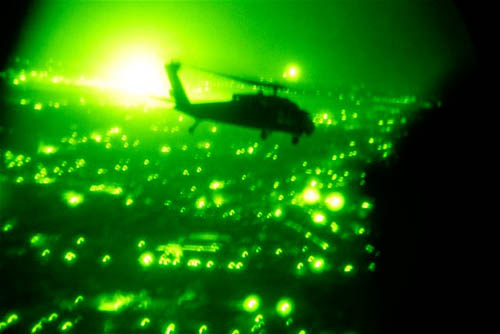 [Image: U.S. helicopter over Baghdad, via (scroll down)].
[Image: U.S. helicopter over Baghdad, via (scroll down)].
I've mentioned The Forever War by Dexter Filkins before, but I was struck again the other day by a passage in which Filkins catalogs the mechanically unprecedented sounds of the American siege of Falluja, a collection of noises so alien and overpowering that he describes it as "an entire ecosystem" with its own hidden predators and prey.
Filkins writes that "rocket-propelled grenades whizzed out of the darkness, striking the M-1s and exploding but doing no harm. Whoosh-bang, like a fireworks show. Whoosh-bang." He quickly adds, however, that "the real weirdness was circling above."
- The night sky echoed with pops and pings, the invisible sounds of frantic action. Most were being made by the AC-130 gunships, whose propellers were putting out a reassuring hum. But over the droning came stranger sounds: the plane's Gatling gun let out long, deep burps at volumes that were symphonic. Its 105mm cannon made a popping sound, the same as you would hear from a machine that served tennis balls. A pop! followed by a boom! Pop-boom. And then there was the insect buzz of the ScanEagle, the pilotless airplane that hovered above us and beamed images back to base. It was as if we were witnessing the violent struggles of an entire ecosystem, a clash of airborne nocturnal beasts we could not see.
But, while an acoustic history of war has yet to be written—though some have treated sound itself as war—it would be a fascinating study to pursue.